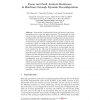Free Online Productivity Tools
i2Speak
i2Symbol
i2OCR
iTex2Img
iWeb2Print
iWeb2Shot
i2Type
iPdf2Split
iPdf2Merge
i2Bopomofo
i2Arabic
i2Style
i2Image
i2PDF
iLatex2Rtf
Sci2ools
CHES
2008
Springer
2008
Springer
Power and Fault Analysis Resistance in Hardware through Dynamic Reconfiguration
Dynamically reconfigurable systems are known to have many advantages such as area and power reduction. The drawbacks of these systems are the reconfiguration delay and the overhead needed to provide reconfigurability. We show that dynamic reconfiguration can also improve the resistance of cryptographic systems against physical attacks. First, we demonstrate how dynamic reconfiguration can realize a range of countermeasures which are standard for software implementations and that were practically not portable to hardware so far. Second, we introduce a new class of countermeasure that, to the best of our knowledge, has not been considered so far. This type of countermeasure provides increased resistance, in particular against fault attacks, by randomly changing the physical location of functional blocks on the chip area at run-time. Third, we show how fault detection can be provided on certain devices with negligible area-overhead. The partial bitstreams can be read back from the reconfi...
| Added | 12 Oct 2010 |
| Updated | 12 Oct 2010 |
| Type | Conference |
| Year | 2008 |
| Where | CHES |
| Authors | Nele Mentens, Benedikt Gierlichs, Ingrid Verbauwhede |
Comments (0)

